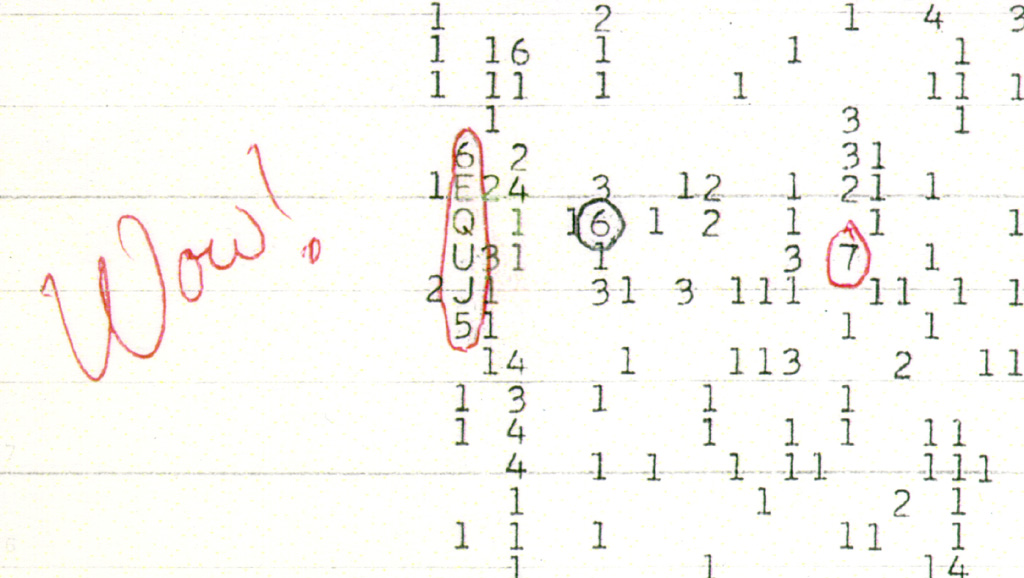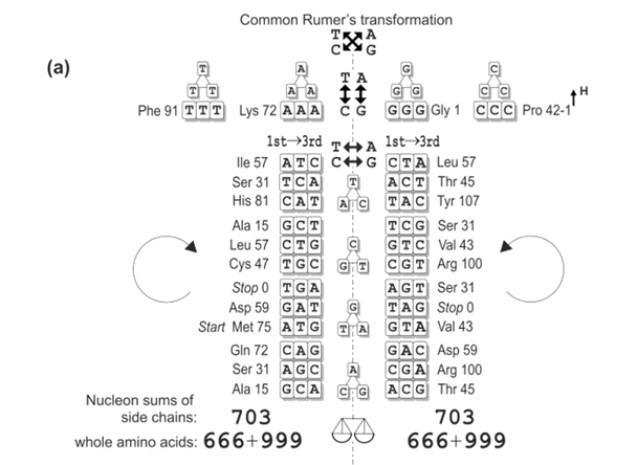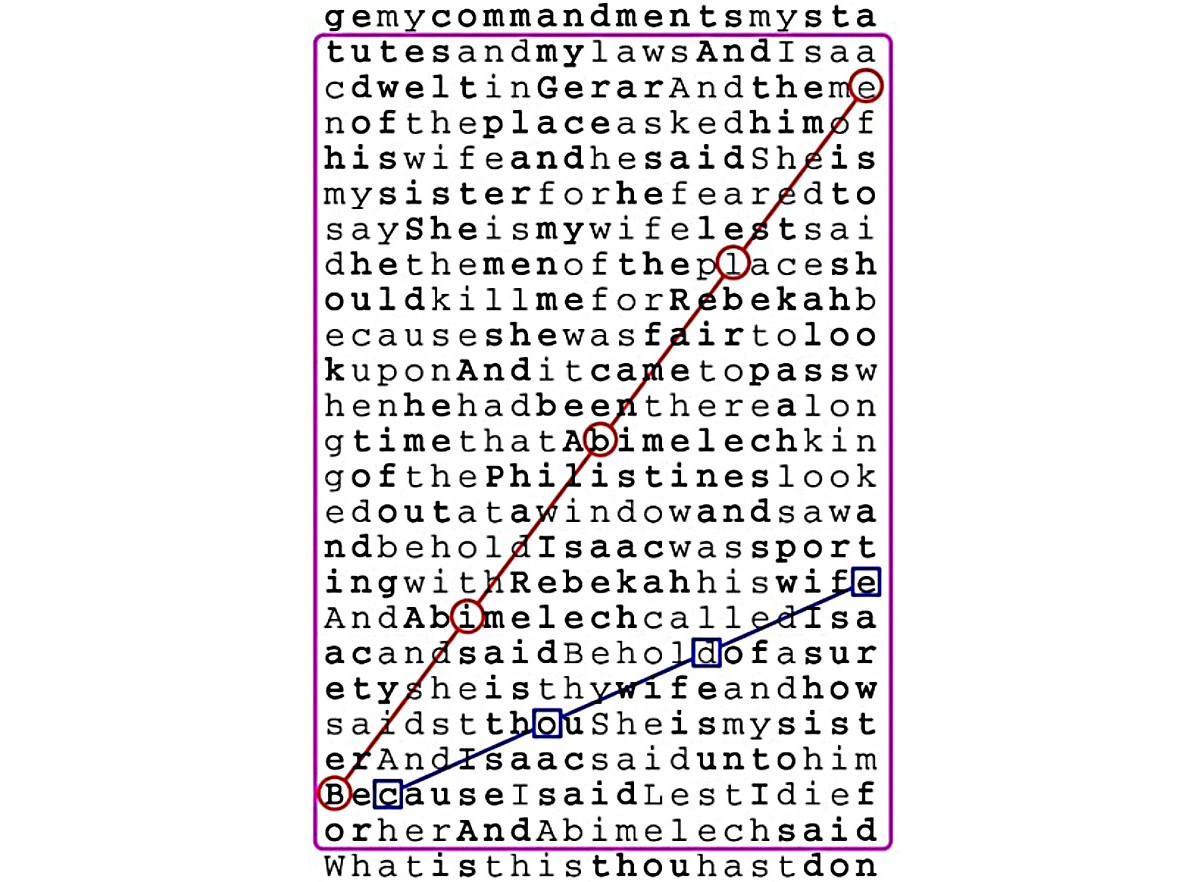Does the genetic code reveal a Wow! signal?
A team of scientists claim evidence for "intelligent design"

The term “Wow! signal” represents a decade-long mystery in astronomy: In 1977, the astrophysicist Jerry Ehman received a strong narrowband radio signal on the frequency of the 21 cm line of hydrogen with the gigantic big-ear radio telescope in Delaware in the US state of Ohio. There seemed to be no natural explanation for the persisting 72 s signal from the Sagittarius constellation, which was 30 standard deviations above the background noise. The profile of the strong, narrow-band signal corresponds to that of a communication antenna. Its discoverer highlighted the signal on the printout with a red circle and added an expression of astonishment by noting “Wow!” In the period that followed, there was a lively debate among experts as to whether it was an artificially generated or a natural signal. Although objects like pul-sars seem to be a possible source, the controversy continues to this day.
A few years ago, a team of Kazakh scientists published a paper claiming to have discovered a Wow! signal in the genetic code of living beings. The code structure, so they claimed, is statistically so striking that its origin could be explained only by the presumption of an intelligent actor. The paper, published in Icarus, was somewhat off-topic since Icarus is a journal for planetary science rather than molecular biology or evolution. Since then, the paper has been celebrated as evidence for the extraterrestrial origin of the genetic code by support-ers of ancient astronauts and by the intelligent design movement; see, for example, here, here, and here, as well as this arti-cle in a German creationist journal. What’s it all about?
Ominous divisor 37 as a design signal
The authors of the paper are the mathematician Vladimir shCherbak from Al-Farabi University in Kazakhstan and the physicist Maxim Makukov from the Fessenkow Astrophysical Institute. The publisher of Icarus, a refereed journal, is the American Astronomical Society (AAS), an association of professional astronomers. The journal is mainly de-voted to initial publications in planetary scienceand is neither esoteric nor religious.
In order to track down the alleged Wow! signal, shCherbak and Makukov first divided the 20 genetically encoded amino acids into two groups: In the first group, they listed all amino acids that are sufficiently defined by the first two bases of a base triplet (meaning that any change of the third base would not change the amino acid) (Fig. 1). A base triplet or codon is a sequence of three bases (“letters”) on the genetic molecule DNA (or on the RNA) coding for a specific amino acid. The authors placed the remaining amino acids into a second group. Then they calculated the nucleon number (molecular weight) of every amino acid in both groups, as well as the nucleon number of every amino acid basic structure (“block nucleons”) and side chain. Finally, they sorted the numbers and added them up.
After this operation, shCherbak and Makukov came across numerical ratios in which the divisor 37 appears again and again: In the first group, the nucleon sum of all side chains is 333 (= 37 x 3²), that of all “block nucleons” 592 (= 37 x 4²), and the total 925 = (37 x 5²). Moreover: “With 037 cancelled out, this leads to 3² + 4² = 5² – representation of the Egyptian triangle…” (p. 6). The number 37 also appears in the second group; the total number of nucleons in the amino acids is 1110 (= 30 x 37).

shCherbak and Makukov discuss various other examples using different sorting and exchange operations. Another one is discussed in Fig. 2. In all those cases, the divisor 37 appears prominently.

Fig. 2 There are 24 codons, each with three very different bases (A, T, G, and C). shCherbak and Makukov arranged those codons in such a way that their nucleic bases are interchanged according to certain rules: Within each “block” of 3 codons, the first nucleic base is shifted from one row to the next one onto the third position. From block to block, A is exchanged for G, and T for C (and vice versa). On the left and right column, the codons are arranged mirror-imaged. Next to each codon, it is noted which amino acid it codes for, and the molecular weight of the side chains and whole molecules is noted. In total, there are numbers that are completely divisible by 37. Source: shCherbak and Makukov, p. 5.
According to the authors, the frequent appearance of “37”, the emergence of “Egyptian triangles”, etc. are far beyond the statistical significance of randomly generated patterns. Thus, these appearances cannot be explained by natural processes since they are not relevant for biological function. The number “0” is also represented, as a corresponding symbol for start/stop codons. The authors claim: “Nature is indifferent to numerical languages contrived by intelligence to represent quantities, including zero”. Such a “privileged numerical system is therefore a reliable sign of artificiality” (p. 4). Ergo: “Whatever the actual reason behind the decimal system in the code, it appears that it was invented outside the solar system already several billions [of] years ago” (p. 8).
A method reminiscent of the Bible Code

Prothero and Callahan (p. 127) note that the approach of the authors shows clear similarities with the method of the so-called Bible code, which is as also called equidistant letter spacing (ELS). It serves to track down presumed “hidden messages” and prophecies in biblical texts. How does this method work?
To recognize the “message”, a rectangular grid with a constant but arbitrary number of columns and rows is placed over the text, and a freely selectable number of letters is skipped from a starting point in the horizontal and vertical direction. Then meaningful words or word constellations are sought (Fig. 3). According to this method, world historical events such as the Holocaust or 9/11 are said to have been predicted.
The problem is: Since the dimensions of the grid and the number of letters skipped when reading were freely defined, the “researchers” most likely would have come up with different messages, had they chosen the width of the grid differently. Nobody read and verified relevant information that had not already been known.
Prothero and Callahan criticize the fact that the authors use the same subjective method to track down the presumed design signals in the genetic code. shCherbak and Makukov have also freely (meaning: arbitrarily) defined the logical criteria for dividing the amino acids into certain groups as well as the transformation and exchange rules according to which the “magic” sums appear. For example, if we would exchange A for T and G for C (rather than A for G and T for C) in Fig. 2, we would receive completely different sums and divisors. In other words, the authors get only results that they have already produced by their own rules.
The interpretation of start/stop codons as a symbol for numerical 0 is just as arbitrary. And of course, if we interpret start and stop codons as numerical 0 on metaphysical grounds, it is not surprising, that we “discover” a “privileged numerical system”, including 0. Garbage in, garbage out.
The choice of molecular weights (nucleon numbers) of side chains, basic structures and whole molecules as an object of investigation is also arbitrary. It is as arbitrary as the determination of a certain number of letters to be skipped in the Bible code, which is needed to find meaningful word combinations.
Design signals generated by targeted manipulations
There is another, more serious objection to shCherbak and Makukov’s method, which Prothero and Callahan do not mention: It works frequently only by a trick.
The amino acid proline does not fit into the scheme, so the authors modify it. To do so, they formally remove an H atom from the side chain of proline and transfer it to the secondary amino group (see Fig. 4). This makes proline the primary amino acid. The purpose of this operation is to formally “standardize” the basic structures of all amino acids, as the authors mention. This is because proline is the only secondary amino acid in the genetic code.
But “standardizing” means nothing other than purposefully changing facts to introduce the divisor 37 through the back door! In contrast to the other amino acids, the molecular weight of the proline basic structure (73) cannot be divided exactly by 37. This also applies, as discussed in Fig. 1, for the nucleon sum of the side chains. That undesirable fact only changes through the appropriate manipulation of numbers. Without it, the authors would never come up with the “magic” numbers 333 and 592. Strictly speaking, none of the examples in which the amino acid proline occurs, works “smoothly” in the sense of the authors.
To make matters worse, this formal H transfer would lead to an impossible molecule (see Fig. 4). The authors even implicitly admit this by stating that the H transfer in proline “can be simulated only in the mind of a recipient to achieve the array of amino acids with uniform structure. Such nucleon transfer thus appears artificial”. However, exactly this artificial operation, so the authors continue, “seems to be its destination: it protects the patterns from any natural explanation” (p. 3). In other words, targeted manipulations generate artifacts whose origin logically eludes any natural explanation! If that’s not a fatal circular argument, what then?

The power of numerology
Incidentally, it is not surprising that in the (numerical) cosmos, which functions under certain rules and laws, certain order patterns like Egyptian triangles, golden triangles, Fibonacci numbers, ascending numerical sequences, prime numbers, etc. can be found which, as brute facts, neither allow an explanation nor even demand one.
Let’s, for example, look at the natural three-digit numbers with identical digits and form their digit sums (111 = 3, 222 = 6, 333 = 9, etc.). If we divide these numbers by their digit sums, the result is in all cases … 37. Another example: 81 stable chemical elements exist. 81 may be represented formally as a “prime number cross” (3 x 3³). The reciprocal of the number 81 can in turn be approximated by the decimal fraction 0.0123456789 (10) (11) (12)… (here, 10, 11, 12 are the next digits; the parentheses are for convenience). And if we look at Romanesco broccoli, we’ll see that its appearance is strictly mathematical: Its conical turrets are copies of the entire inflorescence, which is known as self-similarity or a fractal structure. Each of those turrets is also a so-called Fibonacci spiral, a sequence of numbers that ensures that one turret of vegetables never grows vertically above another.
Why should these pretty patterns, of which we could construct endless examples, represent design signals? Does it even make sense to ask how probable their “accidental” emergence is? Why 37 rather than 38 or 42? Why not π or e? Why not an alternating sequence of numbers? What if the laws were different? And what message are the “signals” supposed to convey? Shall we assume that a creator liked to line the world up with the number 3 or π and to introduce Fibonacci numbers into the cosmos? Such metaphysical interpretations cannot seriously pass as empirical arguments! All such patterns have no more objectively recognizable meaning (or semantic content) than the “Egyptian triangle” or the “appearance” of 37 in the genetic code.
Last but not least: The more often we try out different mathematical transformations, the higher is the likelihood to find any mathematical pattern. We neither know the total set of possibilities nor how many unsuccessful trials the authors made to find their patterns. We only know that the number of potential mathematical transformations is infinite. Any number of counterexamples without any pattern can be constructed.
In a word, the approach of shCherbak and Makukov is pure number mysticism. They could only read an intelligent pattern from those numbers after they inserted it into the genetic code by convenient operations, targeted manipulations and reckless interpretations. Therefore, we have to agree with Prothero and Callahan (p. 128), who summarize:
The result is a paper that, despite the impressive credentials of its authors and the soundness of the journal it was printed in, is essentially without substance.
The mathematician Underwood Dudley (1997) shows in his book Numerology in an entertaining way what nonsense can be done with such number games.
Martin Neukamm is a German chemist and managing editor of the “AG Evolutionsbiologie” (www.ag-evolutionsbiologie.de), a German scientific association that deals with evolutionary biology and creationism. He has published various articles and books on evolution and creationism in the German language. Matt Young is the moderator of this post.
